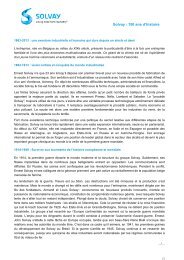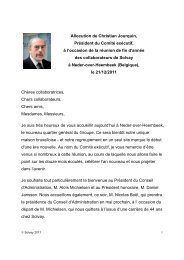Financial Statements - Solvay
Financial Statements - Solvay
Financial Statements - Solvay
Create successful ePaper yourself
Turn your PDF publications into a flip-book with our unique Google optimized e-Paper software.
108<br />
<strong>Solvay</strong> Global Annual Report 2008<br />
The order in which these risk categories are listed is not an indication of their severity or probability. The mitigation efforts<br />
described are no guarantee that risks will not materialize but demonstrate the Group’s efforts to reduce risk exposures<br />
in an entrepreneurial way.<br />
1. Market & Growth – Strategic Risk<br />
Strategic Risk is <strong>Solvay</strong>’s exposure to adverse developments in our markets or our competitive environment as well as<br />
the risk of making erroneous strategic decisions. Examples of such risks are technological leaps allowing the development<br />
of substitute products or manufacturing processes, drastic changes in energy prices, the lack of success of a<br />
new product, product pipeline failures, scarcity of key raw materials, reduction of demand in our main markets as<br />
a consequence of new legislation, events affecting our most important customers, signifi cant imbalances between supply<br />
and demand in our markets, and major social crises.<br />
Prevention and Mitigation efforts<br />
The potential impact of adverse events is managed at Group level, and involves in particular:<br />
– Managing activities and maintaining a balanced portfolio of products,<br />
– Diversifi cation of the customer base in different market segments,<br />
– Adaptation of operations to the changing macroeconomic and market environment,<br />
– Selective vertical integration to limit potential cumulative effects from raw materials,<br />
– Strict fi nancial policy of controlling the net debt to equity ratio.<br />
The periodic review of the main macroeconomic assumptions, market assumptions and key strategic issues of each<br />
Strategic Business Unit (SBU) for the next fi ve years is managed in the strategy and plan process of the Group.<br />
The strategy phase focuses on market and competitive environment assumptions and on the strategic options of each<br />
SBU. The planning phase focuses on the business plan, scenarios, and on the main projects on which execution of<br />
the strategy relies. The strategy and business plans of each SBU are presented by the management of the SBU to,<br />
discussed with and amended and approved by the Executive Committee. The Corporate Development department acts<br />
as facilitator in the process, cross-checking assumptions between the different business units and with external sources.<br />
Corporate Development continuously updates its strategic analysis of the competitive environment. The major strategic<br />
orientations are submitted to the Board of Directors, which has the ultimate responsibility for the Group’s strategy.<br />
2. Supply Chain and Manufacturing Risk<br />
Supply Chain and Manufacturing Risk attached to production units is <strong>Solvay</strong>’s exposure to risks associated with<br />
raw material, suppliers, production units and transportation, such as risks of major equipment failure or damage,<br />
transportation accidents, drastic shortages of raw materials or energy, natural disasters or transportation strikes.<br />
Prevention and Mitigation efforts<br />
Key risk areas are addressed with policies and risk control programs such as health and safety, process safety, risk<br />
engineering, integrated resource planning and supply chain optimization systems (ERP), emergency response, central and<br />
local crisis management, business continuity, etc.<br />
Our plants are regularly subject to audits and in this context the risks of damage to production units and consequential<br />
business interruption events are identifi ed and quantifi ed by risk engineers. <strong>Solvay</strong> evaluates the recommendations and<br />
implements those it fi nds appropriate.<br />
The geographical distribution of production units around the world reduces the overall impact of one production unit<br />
being damaged or interrupted. Some pharmaceutical and specialty products are however, only produced in one single<br />
plant. The inventories of fi nished products and raw material for pharmaceutical and some specialty products are managed<br />
to create buffer stocks.<br />
<strong>Solvay</strong> buys insurance to reduce the fi nancial impact of potential events causing extensive damage and consequential<br />
interruption of supply.


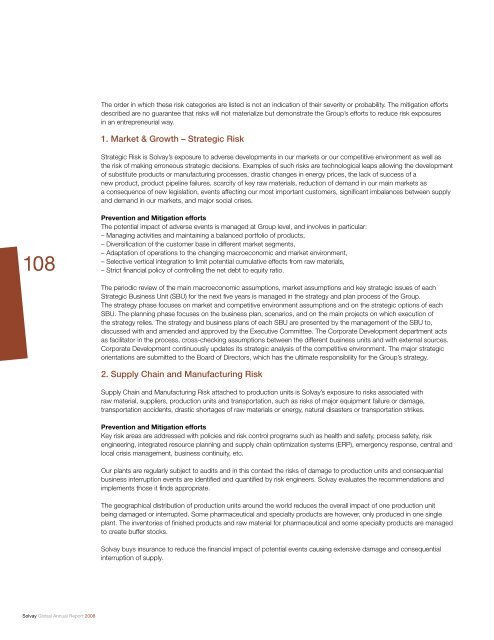

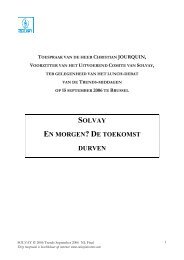
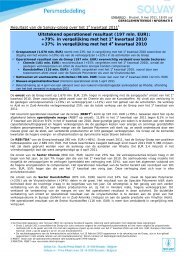

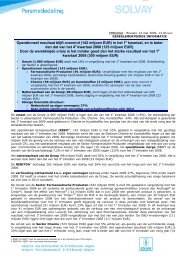
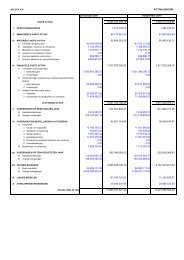


![PROC.1 [LETTRE] - Solvay](https://img.yumpu.com/16585746/1/184x260/proc1-lettre-solvay.jpg?quality=85)
